15 Types of Venomous Caterpillars (With Pictures) – Identification Guide
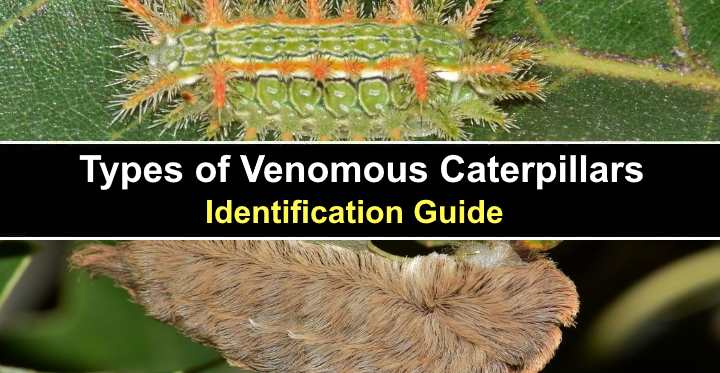
Venomous caterpillars have poisonous bristles, spines, and barbs on their body that can cause a nasty sting. Some types of venomous caterpillars look soft and cute, but their hairy bodies hide toxin-filled spines that can lodge into the skin. Other caterpillars with poisonous spines look dangerous because they have bright coloring, sharp-looking spines, and a menacing appearance.
Most people know that bees, wasps, hornets, and some ants can sting. Few realize that handling certain caterpillars can also be painful. A sting from a venomous caterpillar can result in skin swelling, redness, itchiness, or a burning sensation. However, it’s good to remember that stinging caterpillars don’t attack humans or bite. Adverse skin reactions from a venomous caterpillar’s sting only happen when you handle them.
Identifying species of venomous caterpillars is vital to knowing which ones to avoid. However, many species of hairy caterpillars don’t contain poison-filled sacs and spines and are entirely harmless. Of course, if you’re unsure about the identity of a spiky caterpillar, it’s best to avoid handling it.
This article is an identification guide on how to recognize species of venomous caterpillars. You will learn about the features and characteristics of caterpillar species that have poisonous spines and toxic barbs.
What Makes a Caterpillar Venomous?
Stinging, venomous caterpillars have hollow spiny barbs called urticating setae connected to poisonous glands. Hairy and spiky caterpillars use these as a defense mechanism to deter predators. However, touching the quill-like hairs on the caterpillars releases poison resulting in mild to adverse skin reactions.
According to scientists, symptoms of touching a venomous caterpillar are wide and varied. However, the most common skin reactions include blistering, mild to severe burning pain, swelling, hives, dermatitis, and tissue damage. In addition, some caterpillar species have toxins that can cause symptoms like rheumatoid arthritis.
The toxic chemicals in some caterpillars make them poisonous to birds and small animals. Typically, poisonous caterpillars have bright markings to warm predators. However, the stinging caterpillars will taste foul to birds, and they will quickly learn to avoid them.
Types of Venomous Caterpillars (With Pictures) – Identification Guide
Venomous caterpillars come in all shapes and sizes, and some look like harmless butterfly or moth larvae. Therefore being able to identify dangerous caterpillars can help you avoid getting stung. Please read on to learn about identifying features of the most common caterpillars with venomous setae.
Southern Flannel Moth (Asp) Caterpillar (Megalopyge opercularis)
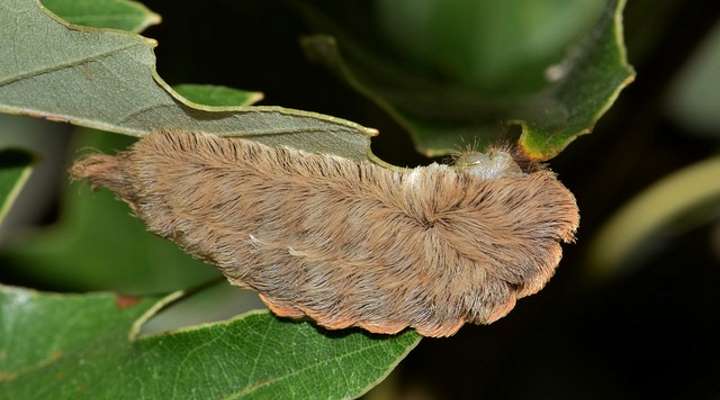
The hairs of the Southern flannel moth caterpillar conceal sharp venomous spines
The southern flannel moth caterpillar is a venomous caterpillar that can be recognized by its covering of long, wavy brown hairs. The furry caterpillar is usually golden brown or dark gray but can sometimes be grayish white. The soft-looking hairs are deceiving because they hide venomous spines that can cause a nasty sting.
The southern flannel moth caterpillar, also known as the ‘puss caterpillar,’ derives its name from its resemblance to tiny Persian cats. Due to its painful bite, this species is also referred to as ‘asp’ caterpillars, as their bites can be as painful as those of a snake. Other names of this dangerous insect include fire caterpillar, woolly slug, or Texas asp.
The venomous hairy brown southern flannel caterpillar measures 1” (25 mm) long, and its oval body tapers at the tail. It emerges as bright yellow with long, fine setae on its body. Through its several instars (growth stages), it becomes a mass of hair—some describe it as having a bad hair day.
The southern flannel caterpillar is considered a dangerous insect due to its nasty sting. Symptoms from the sting of a puss caterpillar can vary in severity and may include headaches, nausea, fever, and seizures. Medical attention is advised if symptoms continue to worsen.
- Adult Stage: Southern flannel moth
- Host Plants: Feeds on various trees and shrubs, including oak, elm, and sycamore
- Habitat and Distribution: Found in diverse habitats such as forests, gardens, and urban areas, primarily in the southern United States, Mexico, and parts of Central America.
- Stinging: The puss caterpillar possesses venomous spines that can cause severe pain and skin irritation if touched
Black-Wave Flannel Moth Caterpillar (Megalopyge crispata)
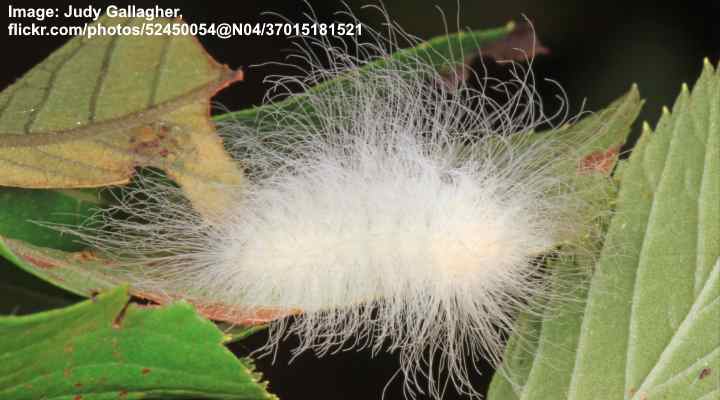
The sharp venomous spines of the black-wave flannel moth caterpillar are hidden underneath its white hairs
The black-wave flannel moth is a venomous, stinging caterpillar covered in long, spindly creamy-white hairs. The non-stinging hairs hide sharp spines attached to poisonous glands. Even lightly brushing against the caterpillar’s wispy hairs can cause a painful sting. If you see a bushy-looking white caterpillar, then it’s best to leave it alone.
The black-wave flannel moth caterpillar measures 0.7” to 1.5” (20 – 40 mm) long. The early growth stages of the moth caterpillar differ from the later stages. The long wispy white setae look like a frilly mess of hair. But as the caterpillar matures, it develops a velvety appearance.
Also called the white flannel moth or crinkled flannel moth, the hairy larva is common on the southeastern coast of North America. This bug is on the list of Florida’s venomous caterpillars.
- Adult Stage: Black-wave flannel Moth
- Host Plants: Various plants including oak, elm, and sycamore
- Habitat and Distribution: Forested areas and gardens across the southern United States and parts of Mexico
- Stinging: This caterpillar is equipped with venomous spines that can cause severe pain and skin irritation if touched
Saddleback Caterpillar (Acharia stimulea)
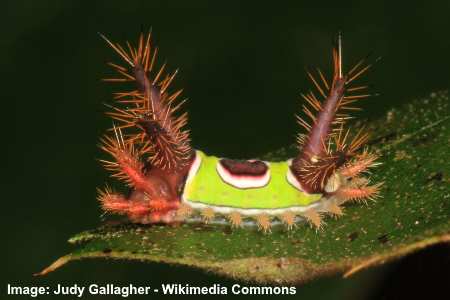
The saddleback caterpillar has spiny venomous horns that cause painful sting
The saddleback caterpillar is easily recognizable as a venomous caterpillar due to its large spike-covered fleshy horns at both ends. The identifying features of this stinging caterpillar include tufts of urticating hairs, a bright lime-green abdomen with an oval brown spot in the center. The brown spot resembles a saddle, while the lime area looks like a saddle blanket. This insect also has eye-like creamy-yellow dots on its head.
The relatively small green and brown saddleback caterpillar grows up to 0.78” (20 mm) long and 0.27” (7 mm) wide. You can find this striking caterpillar in warmer states in North America, feeding on oak, maple, holly, elm, and dogwood trees.
The saddleback caterpillar’s tubercles and spines release toxins when broken. A saddleback caterpillar venomous sting results in burning sensations, redness, blistering, migraines, and gastrointestinal symptoms.While stings from the saddleback caterpillar are not generally life-threatening, it is advisable to seek medical attention. As with bee and wasp stings, some people can be particularly sensitive to the saddleback venom.
- Adult Stage: Saddleback moth
- Host Plants: Feeds on a variety of plants including elm, sycamore, and maple, as well as other deciduous trees and shrubs
- Habitat and Distribution: Found in various habitats such as gardens, forests, and urban areas, primarily in North America
- Stinging: The saddleback caterpillar possesses spines that can cause skin irritation and stinging if touched
Io Moth Caterpillar (Automeris io)
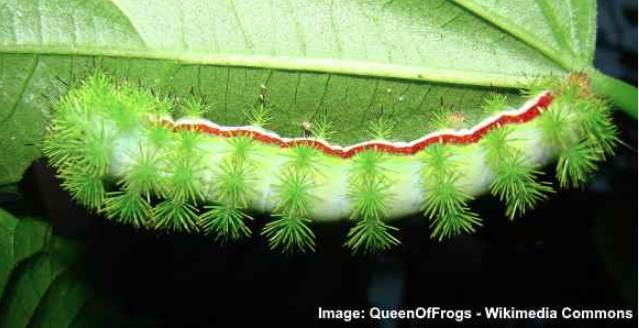
The io moth caterpillar has green spikes that feel very unpleasant if their venom penetrates your skin
The larval stage of the io moth is a large, brightly colored venomous green caterpillar covered in tufts of urticating spines. Its large size, green color, and red and creamy-white stripes along its abdomen make the io moth caterpillar easily recognizable. The io moth caterpillar grows up to 2.7” (70 mm) long.
The io moth starts life as an orange or reddish-brown caterpillar before turning into a large green one. Its green body is covered in bands of spiny tufts containing toxins. In their final instar, a prominent dark red and white band is visible along its sides.
- Adult Stage: Transforms into the io moth
- Host Plants: The caterpillar primarily feeds on a variety of broadleaf trees and shrubs, including corn, roses, willow, linden, elm, oak, locust, apple, beech, ash, currant, and clover
- Habitat and Distribution: Commonly found in gardens, forests, and meadows across North America, particularly in the eastern and central regions
- Stinging: May deliver a painful sting if handled
Hag Moth Caterpillar (Phobetron pithecium)
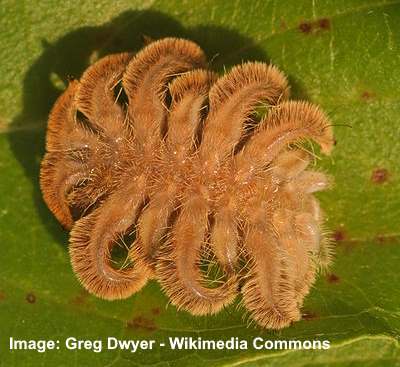
The venomous hairs on the hag moth caterpillar can cause skin irritation
The hag moth larva is one of the strangest venomous caterpillars you’ll come across. The unusual furry brown caterpillar has 18 spine-covered projections on its flattened, hair-covered body. The hag moth looks more like the skin of a brown spider than a moth caterpillar.
Also called the monkey slug, hag moth caterpillars measure 0.6” to 1” (15 – 25 mm) long. You’ll find the bizarre-looking caterpillar on host plants such as apple, birch, oak, chestnut, willow, and hickory trees. The brown bug is common throughout the eastern United States.
- Adult Stage: Transforms into a moth
- Caterpillar Feeds on: Various host plants such as apple, birch, oak, chestnut, willow, and hickory trees
- Habitat: Found in wooded areas and gardens; primarily found in North America
- Stinging: Yes, they have stinging hairs that can cause skin irritation upon contact
White Cedar Moth Caterpillar (Leptocneria reducta)

The white cedar moth caterpillar is covered in venomous urticating hairs all over its body
The white cedar moth larva is a cylindrical dark brown caterpillar covered in irritating bristles. The dark caterpillars have a distinct spiny appearance due to the long pencil setae covering its body. Other features to identify it are its orange feet and faint yellow line along its back.
White cedar moth caterpillars measure around 1.57” (40 mm) long. A characteristic habit of these stinging caterpillars is that they move in groups to defoliate chinaberry or white cedar trees.
These urticating hairs can sting, causing allergic skin reactions like dermatitis, redness, and itching in some people.
- Adult Stage: White cedar moth
- Host Plants: Feeds primarily on the foliage of white cedar trees and other coniferous plants
- Habitat and Distribution: Found in coniferous forests and woodlands, especially in the eastern and central parts of North America
- Stinging: Can cause skin irritation in some people
Spiny Oak Slug (Euclea delphinii)
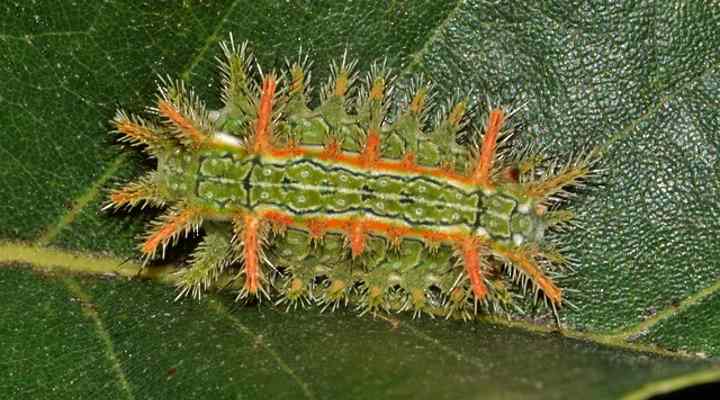
The green and orange spiny oak slug caterpillar has venomous spines that can cause adverse reaction
The venomous spiny oak slug is an unusual caterpillar with fleshy, spine-covered protections along its back and sides. The eye-catching larva is typically green with two orange stripes on its back. Additionally, greenish ringed patterns give the caterpillar a distinct pattern. The spiny oak slug measures up to 0.78” (20 mm).
The hollow spines on the spiny oak caterpillar attach to toxin glands. These can easily puncture the skin, releasing the poison that results in an adverse dermatological reaction. Symptoms of a spiny oak slug sting include localized redness, stinging sensation, and skin inflammation.
- Adult Stage: Transforms into the spiny oak slug moth
- Host Plants: The caterpillar primarily feeds on oak and other hardwood trees
- Habitat and Distribution: Found in woodlands and gardens in East of central Texas and north of Oklahoma
- Stinging: The tufts of toxic spines sticking out around the sides are the stinging part of this caterpillar. There are also venomous horns at either end as well as on the back
Buck Moth Caterpillar (Hemileuca maia)
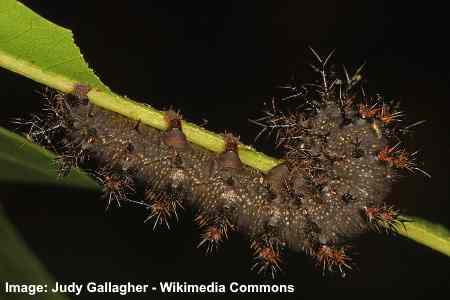
The buck moth caterpillar is a large stinging caterpillar and one of the most venomous ones
The larva of the buck moth is a large, dark brown spiky caterpillar covered in tiny white dots. The spine-covered, brownish multi-branched projections on the dark caterpillar are attached to venomous glands in its body. The black or dark brown larva also has reddish-brown feet. Some Hemileuca maia species appear as brown striped caterpillars.
The buck moth caterpillar grows up to 2.5” (65 mm) before its pupal stage. You will often find the spiny black caterpillar feeding on various species of oak trees.
This venomous caterpillar has hollow quill-like hairs attached to poison sacs. A sting from the caterpillar can cause skin itching, burning, and severe irritation. In some cases, the caterpillar’s sting can cause nausea.
- Adult Stage: Buck moth
- Host Plants: Feeds on a variety of plants including oaks, willows, and various other hardwood trees and shrubs
- Habitat and Distribution: Found in open woodlands, meadows, and gardens across the southeastern United States
- Stinging: The buck moth caterpillar is equipped with venomous spines that can cause skin irritation and a painful sting if touched
White Flannel Moth Caterpillar (Norape ovina)
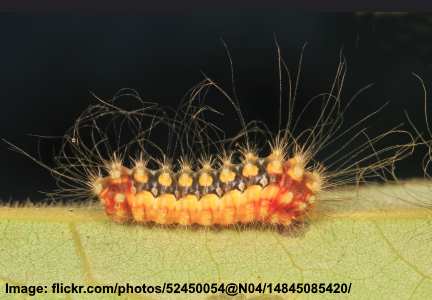
The venomous spines on the white flannel moth caterpillar can cause a painful sting
The larva of the white flannel moth is an eye-catching yellow caterpillar with a large black band on its back and rusty-red ends. Other identifying features of the venomous caterpillar are its tufts of yellow hairs, wispy black setae, short stinging needle-like hairs, and whitish spots on its back.
The white flannel moth caterpillar grows 1” to 1.25” (25 mm to 31 mm) long. The yellow and black caterpillar is common in Florida, Texas, Washington, D.C., and south toward Mexico.
Doctors say that symptoms of a white flannel moth caterpillar sting are urticarial dermatitis caused by venom-filled hairs puncturing the skin.
- Adult Stage: White flannel moth
- Host Plants: Feeds on a variety of plants including oak, hickory, and sycamore trees
- Habitat and Distribution: Can be found in forests, gardens, and other wooded areas across the southern United States and parts of Mexico
- Stinging: The white flannel moth caterpillar possesses venomous spines that can cause skin irritation and a painful sting if touched
Stinging Rose Caterpillar (Parasa indetermina)
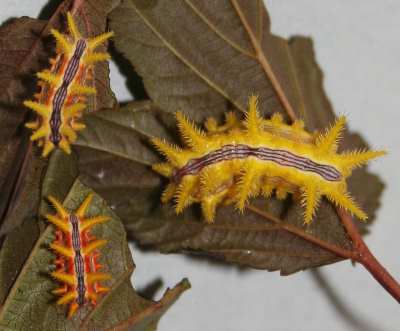
The stinging rose caterpillar has clusters of toxic spikes along its body
The stinging rose caterpillar is a brightly colored flattened caterpillar with yellow or orange spine-covered spikey toxin-filled projections. The venomous stinging caterpillar is easily recognizable by its black, white, orange, and red line running along its back. The colorful but dangerous caterpillar measures 1” (25 mm) long.
Each of the seven pairs of spiny horns is filled with toxins that cause severe irritation. Brushing against the caterpillar results in a nasty sting, with skin swelling and rashes that can last for days.
- Adult Stage: Stinging rose caterpillar moth
- Host Plants: Feeds on a variety of plants including rose bushes, hibiscus, and other ornamental plants
- Habitat and Distribution: Found in gardens, parks, and forested areas, primarily in North America
- Stinging: The stinging rose caterpillar possesses spines that can cause skin irritation and stinging if touched
Pine Processionary Moth Caterpillar (Thaumetopoea pityocampa)
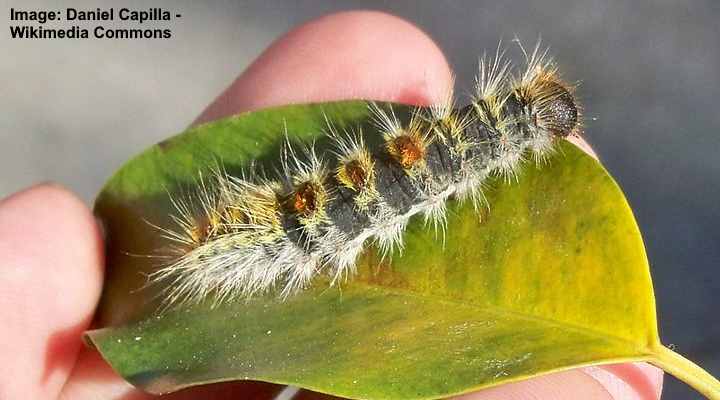
The venomous pine processionary moth caterpillar can be found in coniferous forests
The larva of the pine processionary moth is a black caterpillar with bands of yellowish-white toxin-filled hairs, amber spots, and a rounded head. The distinctive habit of this stinging caterpillar is its processionary behavior as hundreds of hairy caterpillars move in a line to find new pine trees to defoliate.
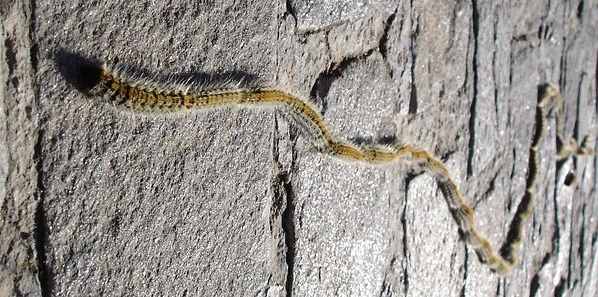
A line of pine processionary moth caterpillars
Mature pine processionary caterpillars grow up to 1.57” (40 mm) long. The irritating hairs covering the black worm-like creature contain urticating chemicals that cause intense and continuous itching. The caterpillar’s sting may result in hives, contact dermatitis, pain, and small red bumps.
The most significant damage pine processionary caterpillars cause is in coniferous forests. According to some sources, this destructive caterpillar causes economic damage to forests in southern Europe, Asia, and North Africa.
- Adult Stage: Pine processionary moth
- Host Plants: Feeds primarily on the needles of pine trees, but also oak, cedar, and cypress trees
- Habitat and Distribution: Found in pine forests and woodlands, primarily across Southern Europe, North Africa, and parts of the Middle East
- Stinging: The pine processionary moth caterpillar is known for its urticating hairs, which can cause skin irritation, allergic reactions, and respiratory issues in humans and animals
Giant Silkworm Moth Caterpillar (Lonomia obliqua)
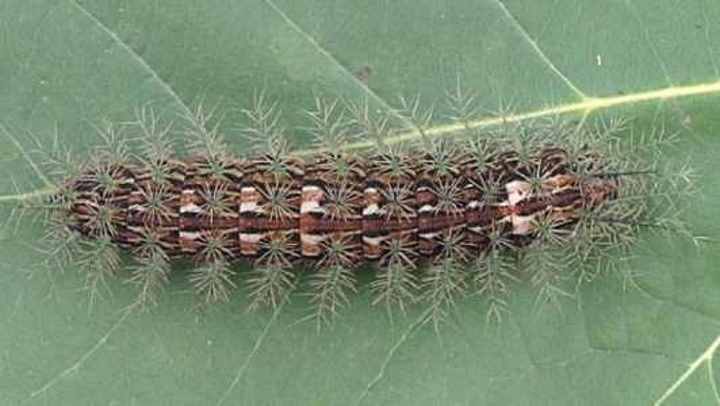
The giant venomous silkworm moth caterpillar can be dangerous
The larva of the giant silkworm moth is a dangerous hairy brown caterpillar with venomous bristles. The cylindrical worm-like brown caterpillar has white and tan markings on its back. The caterpillar is covered in multi-branched pale greenish spines containing a potentially deadly venom.
Giant silkworm moth caterpillars measure 1.77” to 2.1” (45 to 55 mm) long. Although they are typically brown, the caterpillars can also be a green color.
The venomous spines of Lonomia obliqua contain a poison that has anticoagulant properties. This can cause swelling, redness, pain, and internal bleeding.
- Adult Stage: Giant silkworm moth
- Host Plants: Feeds on a variety of trees, including oak, guava, and other broad-leaved trees
- Habitat and Distribution: Found in tropical and subtropical regions, primarily in South and Central America
- Stinging: The giant silkworm moth caterpillar possesses venomous spines that can cause severe skin irritation and potentially life-threatening reactions in humans if touched
American Dagger Moth Caterpillar (Acronicta americana)
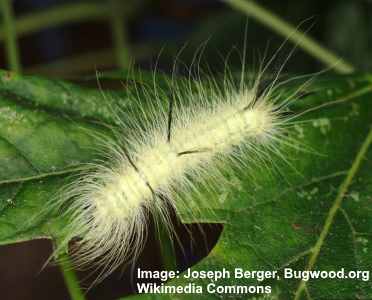
The venomous American dagger moth caterpillar can be identified by its distinct yellow-whitish hairy look
The larva of the American dagger moth is a venomous hairy yellow-whitish caterpillar with several pairs of long black pencil bristle hairs. The slender caterpillars have stinging hairs containing toxic venom that can cause severe skin irritation. The furry pale yellow caterpillar grows to 2” (50 mm) long.
The American dagger moth caterpillar feeds on the foliage of oak, maple, elm, ash, and other hardwood trees. The caterpillars are most active from July through October. The venomous yellowish caterpillar does harm when its toxic bristles break off and get embedded in the skin.
- Adult Stage: American dagger moth
- Host Plants: Feeds on a variety of deciduous trees and shrubs, including birch, elm, oak, and maple
- Habitat and Distribution: Found in various habitats such as forests, woodlands, and urban areas, primarily in North America
- Stinging: The hairs of the American dagger caterpillar cause a stinging sensation that can develop into a rash in some people
Hickory Tussock Caterpillar (Lophocampa caryae)

The hairy hickory tussock caterpillar has black patterns along its white back
The larva of the hickory tussock moth is a black and white caterpillar covered in rash-causing tuffs of irritating hairs. Identifying features of the worm-like caterpillar are long white pencil hairs at either end, bands of black dots traversing a white body, and irritating black tufts on its back.
Hickory tussock caterpillars grow up to 1.77” (45 mm). The caterpillars tend to feed in large groups and can completely defoliate willow, pecan, hickory, and walnut trees. However, the gorging white and black caterpillars rarely damage trees entirely.
The urticating tufts can cause skin irritation because the microscopic, barbed spines can lodge in the skin. According to some reports, the caterpillar isn’t venomous, but its stinging spines cause skin reactions like venomous barbs would.
- Adult Stage: Transforms into the hickory tussock moth
- Host Plants: The caterpillar primarily feeds on hickory and walnut trees
- Habitat and Distribution: Found in forests and woodlands across North America
- Stinging: Yes, the hairs of this caterpillar can cause skin irritation
How Long do Venomous Caterpillar Stings Last?
The pain, swelling, and burning sensation from a venomous caterpillar sting can last anywhere from an hour to a few days. If allergic reactions occur, seeking medical attention is crucial. It is also important to provide a detailed description of the type of venomous caterpillar that stung you.
What do Venomous Caterpillars Turn Into?
Venomous caterpillars transform into moths or butterflies during the pupal stage, forming a chrysalis or cocoon before emerging as adults.
What Should You Do If You Are Stung by a Venomous Caterpillar?
If you are stung by a venomous caterpillar, wash the affected area with soap and water, apply a cold compress, and seek medical attention if symptoms persist or worsen. You are also advised to seek medical attention if any severe reaction or allergic reaction occurs.
What is the Most Venomous Caterpillar?
The most venomous caterpillar is often considered to be the larval form of the Lonomia genus of moths, particularly the species Lonomia obliqua, commonly known as the South American or giant silkworm moth. This caterpillar is found in South America, primarily in countries such as Brazil and Argentina.
The venom of the Lonomia obliqua caterpillar contains a potent anticoagulant that can lead to severe internal bleeding, which can be life-threatening if not promptly treated. Contact with the spines of this venomous caterpillar can cause intense pain, swelling, and other severe allergic reactions.
Related articles:
